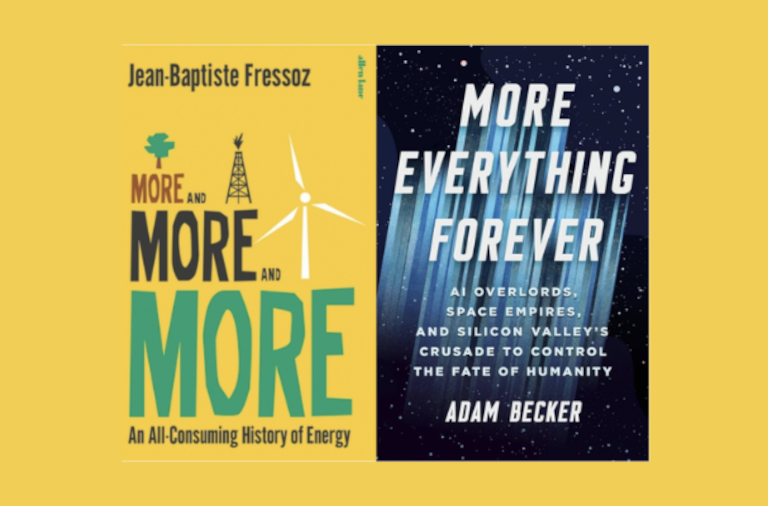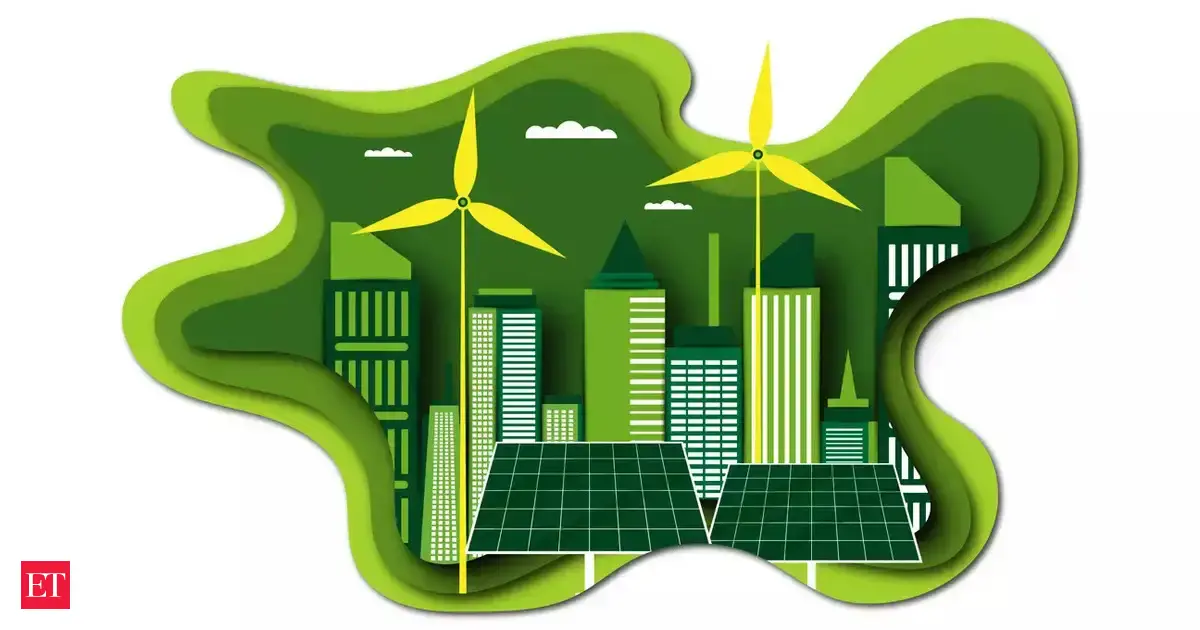Copyright Resilience

Jean-Baptiste Fressoz (2024). More and More and More An All-Consuming History of Energy, Allen Lane Adam Becker (2025). More Everything Forever AI Overlords, Space Empires, and Silicon Valley’s Crusade to Control the Fate of Humanity, Basic Books Dammed to extinction? Drowned. Buried. Burned. Crushed. Lost – and gone forever. The fossilised bones, leaves, shells and other remains of the animals and plants which lived in this area millions of years ago. The habitats and hunting grounds of the plants and animals which lived in this area for hundreds of thousands of years. The trails, tools and campsites, the buildings, gardens, orchards and roads of the humans who passed this way, or lived and worked here, for centuries. The glint of gold in a fossicker’s pan; the glow of gold on a perfectly-ripened apricot. All gone – in less than a decade. I saw it fall….1) Normal, natural, evolutionary extinction takes millions of years. Barring extremely rare events (like an asteroid strike) it takes millions of years for one species to go extinct and (often) be replaced by another species in the same genus. But in the past century, the pace has quickened. Abnormal, unnatural, non-evolutionary extinction is now a thing. 2) I knew from reading studies of it happening that it was a thing, but it wasn’t until I read Fressoz and Becker’s books, back to back, that I became clearer about why it is happening now. I also learned more about the efforts that those responsible for it are engaging in to create the perception of an alternative reality. As Fressoz shows, countries historically responsible for the climate crisis and the colonization of the atmosphere – such as the USA – chose to “play the technology card” in crucial discussions such as the 1992 Rio Earth Summit, instead of acknowledging their historical responsibility. Such a decision not only builds on the fiction of the transition, but doubles down on the colonial implications that are rooted in the unequal distribution and access to such technological assets. These people have been spending millions to divert attention from the slide to extinction, and to promise its opposite instead. With this knowledge, I was able to draw a direct line of connection from the construction of the Clyde Dam,which dammed the Clutha Gorge and all that lived there to eternal extinction, 3)) to tech billionaire Peter Thiel and his recent investment in re-starting a former US government uranium enrichment plant in Western Kentucky. 4) It’s only an hour’s drive south, part of it along the artificial shores of Lake Dunstan, from Clyde to Wanaka. In 2015 one of the many companies connected with newly-minted New Zealand citizen Peter Thiel bought 193 ha/477 acres of former farmland beside Lake Wanaka, with a view to building a luxury lodge (and bunker) to escape whatever apocalypse might be coming up north. 5) Ten years later, Thiel’s ‘investments’ in getting Donald Trump and JD Vance elected had gone well, and millions and millions of dollars of US public money was flowing to his companies. So having been refused planning permission for his luxury Wanaka bunker plans, he abandoned his ‘escape the apocalypse by moving Down Under’ fantasy and doubled down on his efforts to create said apocalypse from the USA. 6) Five centuries of painful extractions During the past five centuries the third rock from the Sun – planet Earth – has been changed much more significantly by human actions than in the previous 300,000 years or so of the existence of Homo sapiens. There are now numerous books and academic articles which document what has happened, and when and how it has happened, in addition to the work on human-caused extinctions. 7) In More and More and More, French historian Jean-Baptiste Fressoz systematically sets out the facts and figures on the intensification and extensification of the extraction and use of the raw materials required to create the energy necessary to power industrial production and consumption processes and practices over those centuries. He also points out the extent to which all these processes and practices are connected with and rely upon each other. For example, coal is burned to create energy to smelt steel which is formed into tools and machines to extract more coal. That energy and those tools and machines might also be used to mine the uranium and sand needed as part of the construction of a nuclear power plant, which then provides the energy for a data centre, which powers the mining of cryptocurrencies. Fressoz documents the way in which the use of raw materials, including those used to generate energy, has increased dramatically in recent decades. At the same time, talk of a ‘green energy transition’ has arisen, and an increase in the construction and use of non-fossil or ‘renewable’ energy sources has also occurred. (Wait a minute! What are these ‘renewable’ energy sources made of, how are they made, and how is the power they generate delivered?) Fressoz shows that while solar and wind power energy generation has indeed increased over the past few decades, so has energy derived from burning fossil fuels, so that the absolute contribution of fossil fuels to world energy use has not changed at all, and continues to sit at around 80%. ‘Transition’ is a fiction. Fressoz shows how this deception was achieved, by means of a switch from absolute to relative measuring techniques. In the book, Fressoz argues that each addition of energy sources to the global matrix in fact entails an increase of all others that preceded it. So-called renewables are built on the expansion of oil, coal and even wood. Fressoz argues that, in fact, this is not only a problem of addition, but a “symbiotic increase of all energy sources” needed to feed capitalism’s relentless demand for energy. The cover of Fressoz’ More and More and More Why was this done? Where did the idea that H.sapiens both could and should keep using (up) more and more and more of Earth come from, and how (on Earth) did this get presented as a good thing, and highly desirable, rather than extremely problematic – and not at all sustainable? This is where I started noticing the overlap between Fressoz’s account of one set of engineers and moneymen, and Becker’s account of another set. They were divided by very little time (a few decades) and not much space (most of them were/are located in the USA). Some of them even have family links. Rather disturbing family links… The engineers of extinction More Everything Forever does not deal with the colonisation and extraction of Earth. Rather, Becker makes the irrefutable case for why and how H.sapiens will never ever ever exist anywhere other than Earth. Even if there are other planets in the Universe where conditions are just right for supporting the existence of mammals like us, they can not and never will be reached (let alone settled) given the vast distances between Earth and them, and the impossibility of humans travelling that far. So why (and how) on Earth is this continual stream of BS about ‘conquering’ space being produced, along with the equal BS that this will be good for – indeed, the salvation of – what the BS artists call ‘humanity’. Becker’s book deals with the creation of institutes, centres, think tanks, university departments (even whole universities), all funded with hundreds of millions of dollars over the past two-three decades, and all claiming to provide a credible analysis of where ‘humanity’ is at now, and where it both could and should be in the future. The snake oil they peddle includes accerationalism, AI apocalyse, AI safety, AI anything and everything, applied rationality, cosmism, cyronics, effective altruism, extropianism, futurism, longtermism, the Singularity, techno-optimism, terraforming, transhumanism – and more. It’s all fiction, dressed up as science. The Cover of Becker’s More, Everything, Forever Technological utopianism as epitomised by the above list of recent examples is not new. It has been around for over a century. 8) It was present in the 1920s and 1930s when the ideas of government by ‘technocracy’ were developed in both the USA and USSR. Space travel was not envisaged then, but government by engineers rather than the elected or appointed representatives of citizens was. Fressoz’s book has a chapter on the technocracy movement of the 1930s, with details on the largest one, Technocracy Inc.. He follows this with a chapter on the ‘atomic Malthusians’, the engineers who succeeded the technocrats and shared some of their ideas about the best future for humans. His penultimate chapter, ‘Play the technology card’ discusses the extent to which new, hypothetical, unproven and even totally fanciful technologies have been and are being consistently promoted as solutions to growing energy demand and increasing planetary heat – by those who do not care about the accelerating use and negative impacts of non-renewable energy sources. Becker’s book takes up the storyline of proposing new, hypothetical, unproven and even totally fanciful technologies as solutions to current problems, or improvements on what already exists. He traces some of it to the science fiction writing of the mid twentieth century, with particular emphasis on the stories involving visiting or colonising other planets. These were mostly written in the 1950s and 1960s, and were still popular when the current tech billionaires were boys who took them seriously. Jeff Bezos and Elon Musk (currently competing in the government-subsidised rocket space) were two such boys, although they grew up in very different places – the USA and South Africa. In the latter regard Musk has more in common with Peter Thiel, who also spent his high school years in South Africa. Both young men were influenced by the racist and anti-Jewish philosophies and practices of far right Afrikaners in South Africa. In this respect Musk was following the trail blazed by his Canadian maternal grandfather, Joshua Haldeman who was a card-carrying technocrat in the 1930s and 1940s. Haldeman emigrated to South Africa after World War Two, and actively supported apartheid. Fressoz’s book deals primarily with the creation of myths about energy futures; Becker’s with the creation of myths about futures in space. They overlap in their consideration of why such myths are created. Who pays for them to be created; who benefits from their creation? Both books follow the money, from those who are paid to create and spread the myths, to those who benefit from their ‘investment’ in myth-making. Becker ends by proposing that the tech billionaires be brought back to Earth, and help provide real benefit for all, by being taxed 100% on every dollar over $500,000. (Sounds fair to me.) Fressoz has no proposals, just a warning against being fatally attracted to the siren songs of those who promise brighter futures, while destroying any chance of such in the present – and future. Both books provide a valuable corrective to the idea that new technologies always represent ‘progress’, and that more technology is essential if ‘humanity’ is to reach its supposed full potential. The trouble is, by ‘humanity’, the technologists don’t mean thee and me. They mean ‘rich American men like them’, not people who are black, brown, indigenous, poor, unemployed, manual or service workers, disabled, female, queer, a recent immigrant, or any combination of the above. So we’ll have to find our own ways to a better future, and one way to start would be by doing a reality check on people who over-promise in bad faith in the present. I found that reading Fressoz and Becker helped a lot when it came to understanding what is really going down – and where it might all end up. 1)In the late 1980s paleontologists, archeologists and other scientists were making hurried last surveys of whatever could be found in the Clutha Gorge and surrounds, before the land was drowned by Lake Dunstan (which began filling in 1992). I was fortunate to be taken to sites in the gorge where I was shown fossil casuarina leaves. These were dated from the early Miocene period, which was 5.3 – 23 million years ago, when the area they were found in was a lot warmer than it is today. The average annual global temperature was at least 17-18 degrees Celsius, and possibly even higher. Today casuarinas are extinct in a much cooler New Zealand. I was also shown fossil bivalve shells, and moa coprolites – fossilised faeces! More recent artefacts included the remains of the campsites of Chinese and other gold panners, and I also saw (and enjoyed eating) perfectly-ripened apricots from an orchard in the gorge. 2)All gone now – and for what? A question Billy Strings asks about over-extraction in the USA, in his evocative song and video Watch It Fall – https://www.youtube.com/watch?v=y97gX9QSwZk 3)In 2014 Elizabeth Kolbert’s book The Sixth Extinction: An Unnatural History (https://en.wikipedia.org/wiki/The_Sixth_Extinction:_An_Unnatural_History) popularised the concept of rising rates of extinction in the late 20th and early 21st centuries to a non-scientific audience. While there is a lack of clarity over the extent to which the current ‘extinction event’ resembles previous known mass extinction events in terms of numbers of species affected, there is no debate over whether human activities are primarily responsible for the extinctions (unlike previous extinction events, which occurred before humans existed). (See https://en.wikipedia.org/wiki/Holocene_extinction ) The increasing rate of extinction has been a concern for conservationist organisations everywhere since the late 20th century. (See, for example – https://www.worldwildlife.org/stories/what-is-the-sixth-mass-extinction-and-what-can-we-do-about-it . 4)For the history of the Clyde Dam and the formation of Lake Dunstan, see https://en.wikipedia.org/wiki/Clyde_Dam For images of some of what was there before the dam was built, see Sold Down The Reservoir https://lowburnbytheclutha.blogspot.com/2009/05/sold-down-reservoir.html 5)See Billionaire Peter Thiel backing first privately developed US uranium enrichment facility in Paducah https://www.wkms.org/energy/2025-07-25/billionaire-peter-thiel-backing-first-privately-developed-us-uranium-enrichment-facility-in-paducah 7)US billionaire Peter Thiel ‘abandons’ Lake Wānaka lodge build – https://www.rnz.co.nz/news/national/523397/us-billionaire-peter-thiel-abandons-lake-wanaka-lodge-build Peter Thiel’s exit from NZ: A decade of investments, controversy, and unmet expectations – https://b2bnews.co.nz/news/peter-thiels-exit-from-new-zealand-a-decade-of-investments-controversy-and-unmet-expectations/ 8)A 1930s movement wanted to merge the US, Canada and Greenland. Here’s why it has modern resonances Dafydd Townley Teaching Fellow in International Security, University of Portsmouth Published: March 22, 2025 8.20am NZDT https://theconversation.com/a-1930s-movement-wanted-to-merge-the-us-canada-and-greenland-heres-why-it-has-modern-resonances-252587 Teaser image credit: Author supplied.



